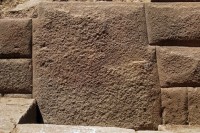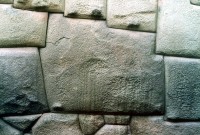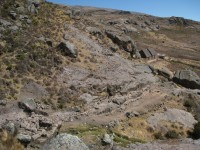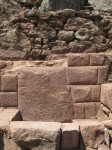 Archaeologists exploring a stretch of the Inca trail network of Qhapaq Ñan that passes through the archaeological site of Incahuasi have discovered a stone cut with 13 angles. The trail is vast, covering 30,000 kilometers and crossing six countries. It was declared a UNESCO World Heritage site this June, which has drawn new attention to the network from researchers, including the section in Incahuasi. While investigating the trail, the archaeological team found a hydraulic system with two masonry fountains connected to canals carved out of the mountain rock. It was one of those fountains that has a large 13-angled cut stone in the center.
Archaeologists exploring a stretch of the Inca trail network of Qhapaq Ñan that passes through the archaeological site of Incahuasi have discovered a stone cut with 13 angles. The trail is vast, covering 30,000 kilometers and crossing six countries. It was declared a UNESCO World Heritage site this June, which has drawn new attention to the network from researchers, including the section in Incahuasi. While investigating the trail, the archaeological team found a hydraulic system with two masonry fountains connected to canals carved out of the mountain rock. It was one of those fountains that has a large 13-angled cut stone in the center.
Inca masonry is famous for its finely hewn polygonal stones that fit together without mortar like intricate jigsaw puzzles. Even today, half a millennium after they were constructed, many of these dry walls are still joined so perfectly you can’t pass a piece of paper between stones. The variety of shapes and precision cutting provided exceptional seismic resistance, hence their longevity even in earthquake-prone areas.
 One particular polygonal stone has become a Peruvian icon: the 12-angled stone in a wall on Hatun Rumiyoc Street in Cusco. The wall is all that remains of the palace of Inca Roca, sixth Sapa Inca (ruler) of the Kingdom of Cusco, and the Stone of Twelve Angles has become a hugely popular tourist attraction. Its unique shape features in logos from beer to railroads.
One particular polygonal stone has become a Peruvian icon: the 12-angled stone in a wall on Hatun Rumiyoc Street in Cusco. The wall is all that remains of the palace of Inca Roca, sixth Sapa Inca (ruler) of the Kingdom of Cusco, and the Stone of Twelve Angles has become a hugely popular tourist attraction. Its unique shape features in logos from beer to railroads.
The fame of the Hatun Rumiyoc stone lends a special cachet to the discovery of a stone with 13 angles. The city of Incahuasi was built in the mid-15th century by Túpac Yupanqui, the 10th Sapa Inca, to serve as a military and administrative center of the empire he expanded south along the coast. He called it New Cusco and deliberately evoked the power and glamour of the great Inca capital by building a smaller version of its monumental structures and planned grid of streets and squares.
 The dry, subtropical desert climate required the construction of extensive canal and irrigation systems for agricultural purposes. Incahuasi is 3,800 meters (12,467 feet) above sea level and was strategically located next to the Viscacha River, the water source for irrigation of the whole valley. Two mountain springs fed the fountains. The water then traveled through the canal system carved from the mountain rock in zig-zag, straight sections and waterfalls that slowed down the flow of water on its descent to the Viscacha.
The dry, subtropical desert climate required the construction of extensive canal and irrigation systems for agricultural purposes. Incahuasi is 3,800 meters (12,467 feet) above sea level and was strategically located next to the Viscacha River, the water source for irrigation of the whole valley. Two mountain springs fed the fountains. The water then traveled through the canal system carved from the mountain rock in zig-zag, straight sections and waterfalls that slowed down the flow of water on its descent to the Viscacha.
 Archaeologists believe the water systems had more than just a practical use. They also held ritual significance. In Andean cultures, bodies of water were considered sacred places of origin. The Incas promoted this notion, emphasizing the symbolic importance of water management as a defining standard for community membership. In Incahuasi, the canal system invoked multiple sacred origins: the mountain springs feeding the fountains, the departure point of the Viscacha to water the valley, which, once the river descends to the coast, becomes an important tributary of the Pisco River.
Archaeologists believe the water systems had more than just a practical use. They also held ritual significance. In Andean cultures, bodies of water were considered sacred places of origin. The Incas promoted this notion, emphasizing the symbolic importance of water management as a defining standard for community membership. In Incahuasi, the canal system invoked multiple sacred origins: the mountain springs feeding the fountains, the departure point of the Viscacha to water the valley, which, once the river descends to the coast, becomes an important tributary of the Pisco River.
So, “Mine goes to 13”?
I’ve often been struck by the contrast between the works of the native American civilisations, and the low esteem in which their descendants are often held. It’s odd: we tend to assume that Egyptians or Iraqis deserve some sort of recognition for the feats of the Pharaohs and ancient Mesopotamia. Why do people – I suppose I mean USAians – tend not to extend the same sort of recognition in their own hemisphere?
Some North Americans don’t understand that the same cultures who built these civilizations are still around. Many have been wrongly taught that the living native people are descended from tribes subservient to the Inca. So it is often ignorance. Not so in some (not all) South American countries, where local indigenous people are sometimes looked down on. But in USA and in Central and South America, there is growing awareness of the living cultures and their highly developed (and still practiced) craftsmanship in many areas. An example is the amazing textiles still being produced in the traditional way. I am a weaver, and I am in awe.
What is wrong with you people. The Spanish were way more advanced than the Incas. They built missions, grand cathedrals, sailng ships. They had horses and artillery. They were even educated and knew math and geometry. They cocnquered the Incas. The Incas were no where near as advanced as the Spanish and the Spanish had no idea how those things were built so much so that it frieghten them into saying that devils must have built them. We can’t reproduce this today with our best of knowledge and you are going to give credit to a pagan tribe of indians who couldn’t even fend off the Spanish. When they were asked by the Spanish “who built this? they replied it wasn’t them. They stated that these ruins were built thousands of years before they arrived by the Varacocha. Common Sense. use it. forgive my spelling. Thankyou